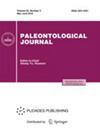第 10 章 细菌古生物学细菌古生物学课程
IF 0.6
4区 地球科学
Q4 PALEONTOLOGY
引用次数: 0
摘要
摘 要 细菌古生物学的发展动摇了一些公认的地球阿新世-新生代演化研究的科学范式。因此,细菌学和古生物学研究偶尔会导致对古地理构造的修正。本文讨论了这门相当年轻的科学学科所取得的主要成就,包括发现古原核和真核微生物及其与地球早期环境的联系,以及在碳质软玉(陨石)中发现微生物化石,这些都改变了我们对泛原生生物和生命起源问题的态度。本文章由计算机程序翻译,如有差异,请以英文原文为准。

Chapter 10. Bacterial Paleontology Lessons
Abstract
The development of bacterial paleontology has shaken some generally accepted scientific paradigms in research on the Archean–Proterozoic evolution of the Earth. Thus, bacterial and paleontological studies occasionally led to a revision of paleogeographical constructions. This paper discusses the main achievements of this rather young scientific discipline, including the finds of ancient prokaryotic and eukaryotic microorganisms and their connection with the early Earth’s environments, as well as the finds of fossilized microorganisms in carbonaceous chondrites (meteorites), which change our attitude toward the problems of panspermia and the origin of life.
求助全文
通过发布文献求助,成功后即可免费获取论文全文。
去求助
来源期刊

Paleontological Journal
地学-古生物学
CiteScore
1.20
自引率
33.30%
发文量
70
审稿时长
6-12 weeks
期刊介绍:
Paleontological Journal (Paleontologicheskii zhurnal) is the principal Russian periodical in paleontology. The journal publishes original work on the anatomy, morphology, and taxonomy of fossil organisms, as well as their distribution, ecology, and origin. It also publishes studies on the evolution of organisms, ecosystems, and the biosphere and provides invaluable information on global biostratigraphy with an emphasis on Eastern Europe and Asia.
 求助内容:
求助内容: 应助结果提醒方式:
应助结果提醒方式:


